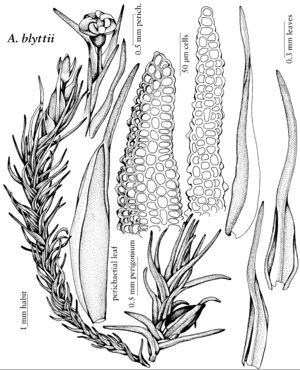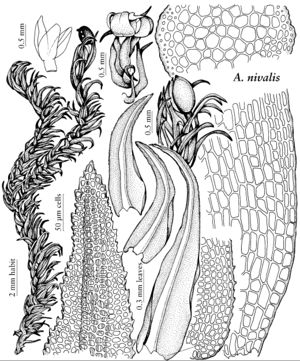Andreaea
Sp. Musc. Frond., 47. 1801 ,.
| Taxon | Illustrator ⠉ | |
|---|---|---|
 | Andreaea blyttii | Patricia M. Eckel |
 | Andreaea nivalis | Patricia M. Eckel |
Plants commonly cemented to substrate. Stems with stalked mucilage hairs in leaf-axils, stalks usually brown. Leaves spiraling around stem in several rows, usually brittle, commonly ending in a distinct apiculus of a single cell; costa sometimes poorly differentiated, sometimes not reaching the leaf insertion; laminal cells with thick longitudinal walls and often pitted or sinuose, transverse walls thin. Capsule 0.5–2 mm.
Distribution
Cosmopolitan
Discussion
Species about 45 (11 in the flora).
Andreaea is easily recognized in the field by the dark green to blackish dense turf strongly adherent to a rock habitat, the brittle leaves, and capsule opening by four longitudinal lateral slits. These species are largely temperate montane to arctic-alpine in distribution, not uncommon on exposed acid rock surfaces. The present treatment follows B. M. Murray’s (1987, 1988, 1988b) detailed and thorough study closely except that Andreaea alpestris is treated as a synonym of A. rupestris and A. crassinervia as a synonym of A. rothii, following M. F. V. Corley et al. (1981), while infraspecific taxa are not recognized. The costa may be interpreted as strongly excurrent when it fills the leaf subula.
Selected References
Lower Taxa
Key
| 1 | Costa absent, leaves mostly lanceolate to ovate or panduriform | > 2 |
| 1 | Costa present, leaves mostly subulate | > 6 |
| 2 | Proximal laminal margins denticulate; Greenland. | Andreaea alpina |
| 2 | Proximal laminal margins entire (occasionally crenulate) | > 3 |
| 3 | Cells of basal laminal margins quadrate. | Andreaea mutabilis |
| 3 | Cells of basal laminal margins mostly rectangular | > 4 |
| 4 | Leaves narrowly lanceolate, medial cell walls pitted and sinuose. | Andreaea sinuosa |
| 4 | Leaves short-lanceolate to panduriform, medial cell walls variously pitted, straight | > 5 |
| 5 | Leaves generally curving or secund, short-lanceolate, widest proximally, apices oblique or symmetric | Andreaea rupestris |
| 5 | Leaves mostly straight, panduriform, widest in distal half, apices usually symmetric | Andreaea obovata |
| 6 | Leaf margins crenulate to strongly denticulate, laminal papillae present, strong; perichaetial leaves little differentiated. | Andreaea nivalis |
| 6 | Leaf margins entire or occasionally weakly crenulate, laminal papillae absent; perichaetial leaves differentiated, convolute-sheathing | > 7 |
| 7 | Spores ca. 10-20 µm; basal laminal cells mostly rectangular, cell walls smooth and straight | Andreaea blyttii |
| 7 | Spores 20-60 µm; basal laminal cells mostly rounded or quadrate to short-rectangular, walls commonly pitted and sinuose | > 8 |
| 8 | Costa weak, flattened distally, commonly not reaching the leaf insertion. | Andreaea heinemannii |
| 8 | Costa moderately differentiated to strong, terete, reaching the leaf insertion | > 9 |
| 9 | Spores usually 50-90 µm. | Andreaea megistospora |
| 9 | Spores usually 35-60 µm | > 10 |
| 10 | Spores usually 35-60 µm. | Andreaea rothii |
| 10 | Spores usually 20-30 µm. | Andreaea schofieldiana |